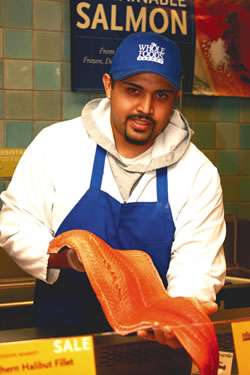EAT, DRINK & PLAY - THE DISH
Don't be Afraid of Fish!
Entertaining the Question
June, 2005 - Issue #8
 |
A: We'll admit it - even these caterers have been intimidated at the fish market. The key to cooking fish is to start simply; pan sauteing with a good accompanying sauce is the perfect place to begin. After all, getting a hot pan sauce and hot fish on the table at the same time isn't so easy because fish cools down quickly.
Your local supermarket has a seafood counter; Whole Foods and Pavillions are especially in-tune with the best offerings. When ordering, be exact with what you want. If you ask for "four fillets" of say, sole or haddock or salmon, you will get four random sizes - and that makes for trouble when cooking. To ensure evenly cooked fillets you need to buy the same size and thickness. Be bold! Ask for "four 5-ounce fillets" or even for "four 5-ounce fillets that are 1/2-inch thick." The fishmonger will be happy to accommodate your requests, and while you are there, pick their brain and ask for tips on the best way to prepare that fish.
For the saute, season the fish with salt and pepper, then put a coat of flour on it. This is what gives it that brown color as you saute it in a skillet with hot oil. Make sure your fillets are in single layer; reduce the heat to medium and cook until the edges of the fillets are opaque and the bottoms are golden brown (about three to four minutes for thick fillets, two to three minutes for thin fillets). Using a spatula, gently flip fillets, and cook on the second side for about two to three minutes more. Here's a little catering secret: to make sure the fish is cooked just right, use a paring knife to peek inside. If the flesh is still translucent, the fish is not yet done; if the flesh is opaque and flakey but still juicy, the fish is ready to come out of the pan. If it is dry, yikes! It has been overcooked. Our other secret to producing hot fish with hot sauce is to make the sauce in its own pan and keep it on a low burner while cooking the fish.
Now that you have conquered your fear of sauteing fish, enjoy this incredible sauce.
Orange Tarragon Sauce with Cream
Makes 1 cup
2 tsp vegetable oil
3 tbsp minced shallot
1 cup fresh orange juice
3 tbsp champagne vinegar (you can use white wine vinegar)
1/4 cup heavy cream
2 tbsp cold unsalted butter
1 tbsp chopped fresh tarragon leaves
Salt and pepper
Heat oil in medium saucepan over medium heat until simmering but not smoking; add shallot and cook, stirring frequently until softened and beginning to color, about 1-1/2 minutes. Add orange juice and vinegar; increase heat to high and bring to boil. Boil until reduced to 3/4 cup, which should take about four to six minutes. Add heavy cream and continue to cook until slightly reduced, about one minute. Remove saucepan from burner, whisk in butter and tarragon until combined, season to taste with salt and pepper. Cover to keep warm. To serve, stir sauce to recombine and spoon over fish fillets.
We are all about garnish here, so decorate that plate with orange wedges. Enjoy!
--------------------------------------------------------------
Cindy and Tamra own RSVP Catering, headquartered in Santa Clarita.
|
||||||||||||||||||||||||||||




